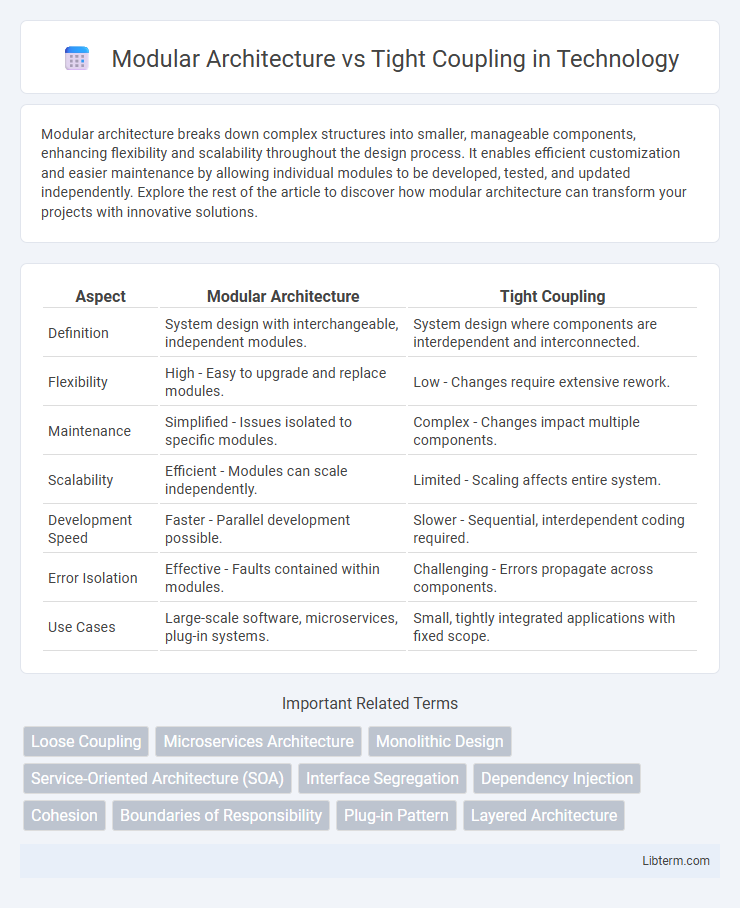Modular architecture breaks down complex structures into smaller, manageable components, enhancing flexibility and scalability throughout the design process. It enables efficient customization and easier maintenance by allowing individual modules to be developed, tested, and updated independently. Explore the rest of the article to discover how modular architecture can transform your projects with innovative solutions.
Table of Comparison
| Aspect | Modular Architecture | Tight Coupling |
|---|---|---|
| Definition | System design with interchangeable, independent modules. | System design where components are interdependent and interconnected. |
| Flexibility | High - Easy to upgrade and replace modules. | Low - Changes require extensive rework. |
| Maintenance | Simplified - Issues isolated to specific modules. | Complex - Changes impact multiple components. |
| Scalability | Efficient - Modules can scale independently. | Limited - Scaling affects entire system. |
| Development Speed | Faster - Parallel development possible. | Slower - Sequential, interdependent coding required. |
| Error Isolation | Effective - Faults contained within modules. | Challenging - Errors propagate across components. |
| Use Cases | Large-scale software, microservices, plug-in systems. | Small, tightly integrated applications with fixed scope. |
Introduction to Modular Architecture and Tight Coupling
Modular architecture organizes software into distinct, independent modules with well-defined interfaces, enhancing maintainability and scalability. Tight coupling refers to a design where components are heavily dependent on each other's internal details, creating challenges in adaptability and testing. Emphasizing modularity reduces interdependencies, facilitating easier updates and improved code reusability.
Defining Modular Architecture
Modular architecture is a design approach that structures a system into discrete, interchangeable components with well-defined interfaces, enhancing maintainability and scalability. Each module operates independently, allowing for easier updates, testing, and parallel development without impacting the entire system. This contrasts sharply with tight coupling, where components are heavily dependent on each other, leading to increased complexity and difficulty in managing changes.
Understanding Tight Coupling
Tight coupling occurs when software components are highly dependent on each other's internal details, leading to reduced flexibility and increased maintenance complexity. This interdependency makes it difficult to modify or replace individual modules without affecting others, causing higher risks during updates or scaling. Understanding tight coupling is essential for designing systems that prioritize modular architecture, which enhances code reusability, scalability, and easier troubleshooting.
Key Differences Between Modular and Tightly Coupled Systems
Modular architecture separates system components into independent, interchangeable modules, enhancing flexibility, scalability, and ease of maintenance compared to tightly coupled systems, where components are heavily interdependent, leading to increased complexity and reduced adaptability. Modular systems enable parallel development and improve fault isolation, while tightly coupled systems often result in cascading failures due to shared dependencies. The key difference lies in the level of component independence, with modular designs prioritizing loose coupling to facilitate system evolution and integration.
Benefits of Modular Architecture
Modular architecture enhances system flexibility by allowing individual components to be developed, tested, and maintained independently, reducing complexity and accelerating development cycles. It improves scalability and adaptability, enabling easy integration of new features without disrupting existing functionalities. This design approach also significantly increases fault isolation and reusability, promoting efficient resource management and long-term system sustainability.
Drawbacks of Tight Coupling in Software Design
Tight coupling in software design leads to decreased flexibility, making it challenging to modify or extend components without impacting others. It causes higher maintenance costs and increased risk of errors since changes in one module often ripple through the system. This design approach hinders scalability and slows down development cycles due to the intertwined dependencies between modules.
Case Studies: Modular vs. Tightly Coupled Systems
Examining case studies of modular versus tightly coupled systems reveals significant differences in scalability, maintainability, and fault isolation. Modular architectures, exemplified by Netflix's microservices approach, allow independent deployment and easier updates, reducing system downtime and enabling rapid feature innovation. In contrast, tightly coupled systems like legacy monoliths often face challenges in adapting to changing requirements quickly, with higher risk of cascading failures due to intertwined components.
Best Practices for Achieving Modularity
Achieving modularity in software architecture requires designing components with clear, well-defined interfaces that minimize dependencies and promote loose coupling. Implementing separation of concerns through encapsulation and adhering to design principles like SOLID ensures that modules remain independently testable and maintainable. Utilizing dependency injection and designing for high cohesion within modules further enhances flexibility and scalability in modular systems.
Transition Strategies: From Tight Coupling to Modularity
Transitioning from tight coupling to modular architecture requires a strategic decomposition of monolithic components into self-contained modules, enhancing maintainability and scalability. Implementing well-defined interfaces and leveraging APIs facilitate clear boundaries, allowing incremental refactoring without disrupting existing functionality. Employing techniques such as domain-driven design and microservices gradually isolates business logic, enabling teams to adopt modular principles while minimizing system downtime.
Future Trends in Software Architecture
Modular architecture enhances software scalability and maintainability by isolating components, enabling easier updates and integration with emerging technologies like microservices and serverless computing. Tight coupling, while potentially improving performance in the short term, restricts flexibility and slows adaptation to evolving requirements and cloud-native environments. Future trends emphasize modularity combined with API-driven development and containerization to support rapid innovation and continuous delivery.
Modular Architecture Infographic

 libterm.com
libterm.com